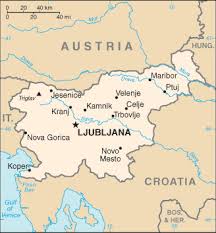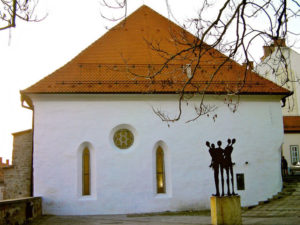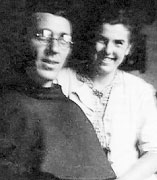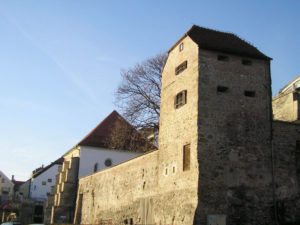 The first Jews arrived in present-day Slovenia in Roman times, with archaeological evidence of Jews found in Maribor, and in the village of Škocjan in Lower Carniola. In the 12th century, Jews arrived to the Slovene Lands fleeing poverty in Italy and central Europe. Even though they were forced to live in ghettos, many Jews prospered. Relations between Jews and the local Christian population were generally peaceful. The first synagogue in Ljubljana is mentioned in 1213. The streets Židovska ulica (“Jewish Street”) and Židovska steza (“Jewish Lane”), which now occupy the area, are still reminiscent of that period. Expulsion of the Jews occurred and the next Jewish occupation was after 1817.
The first Jews arrived in present-day Slovenia in Roman times, with archaeological evidence of Jews found in Maribor, and in the village of Škocjan in Lower Carniola. In the 12th century, Jews arrived to the Slovene Lands fleeing poverty in Italy and central Europe. Even though they were forced to live in ghettos, many Jews prospered. Relations between Jews and the local Christian population were generally peaceful. The first synagogue in Ljubljana is mentioned in 1213. The streets Židovska ulica (“Jewish Street”) and Židovska steza (“Jewish Lane”), which now occupy the area, are still reminiscent of that period. Expulsion of the Jews occurred and the next Jewish occupation was after 1817.
By 1910, only 146 Jews lived in the territory of present-day Slovenia, excluding the Prekmurje region. In 1918, riots broke out against Jews in Prekmurje. Soldiers and locals looted Jewish homes and shops, tortured Jews, and set fire to the synagogue. After the pogrom, the once powerful Beltinci Orthodox Jewish community, numbering 150 in the mid-19th century, disappeared. In 1937 the local authorities demolished the Beltinci synagogue. Prior to World War Two, there were two active synagogues in Slovenia, one in Murska Sobota and one in Lendava.
 According to the 1931 census, there were about 900 Jews in the Drava Banovina, mostly concentrated in Prekmurje. During that period, the Jewish population was reinvigorated by many immigrants fleeing from neighbouring Austria and Nazi Germany to a more tolerant Kingdom of Yugoslavia. In 1940, the Korošec government introduced two antisemitic laws in Yugoslavia, to ban Jews from the food industry and restrict the number of Jewish students in high schools and universities. The overall number of Jews prior to the Axis invasion of Yugoslavia in April 1941 is estimated to have been around 2,500.
According to the 1931 census, there were about 900 Jews in the Drava Banovina, mostly concentrated in Prekmurje. During that period, the Jewish population was reinvigorated by many immigrants fleeing from neighbouring Austria and Nazi Germany to a more tolerant Kingdom of Yugoslavia. In 1940, the Korošec government introduced two antisemitic laws in Yugoslavia, to ban Jews from the food industry and restrict the number of Jewish students in high schools and universities. The overall number of Jews prior to the Axis invasion of Yugoslavia in April 1941 is estimated to have been around 2,500.
The Jewish community, very small even before World War II and the Shoah, was further reduced by the Nazis occupation between 1941 and 1945. The Jews in northern and eastern Slovenia, which was annexed to the Third Reich, were deported to concentration camps in the late spring of 1941. Very few survived. In Ljubljana and in Lower Carniola, which came under Italian occupation, the Jews were relatively safe until September 1943, when most of the zone was occupied by the Nazi German forces. In late 1943, most of them were deported to concentration camps, although some managed to escape, by fleeing to the zones freed by the partisan resistance.
 Mazovec Majda was a Slovenian student from Lubjana, who was studying medicine in Padua. After having visited the Chisanuova Camp, where she was looking for a cousin, Majda started collaborating with Father Placido Cortese and the FraMa Resistance movement during the years of the Nazi-fascist occupation of Northern Italy. After the Armistice, she risked her life by operating as a courier between Lubjana and Padua to transport documents, letters, food and clothing that were useful for the clandestine organization to rescue Jews, refugees, victims of political and military persecution. At the end of the war, after graduating in medicine, she became a highly esteemed cardiologist.
Mazovec Majda was a Slovenian student from Lubjana, who was studying medicine in Padua. After having visited the Chisanuova Camp, where she was looking for a cousin, Majda started collaborating with Father Placido Cortese and the FraMa Resistance movement during the years of the Nazi-fascist occupation of Northern Italy. After the Armistice, she risked her life by operating as a courier between Lubjana and Padua to transport documents, letters, food and clothing that were useful for the clandestine organization to rescue Jews, refugees, victims of political and military persecution. At the end of the war, after graduating in medicine, she became a highly esteemed cardiologist.
 Almost the entire Jewish population of the Prekmurje region was deported to Auschwitz. Very few survived. All together it is estimated that of the 1,500 Jews in Slovenia in 1939, only 200 managed to survive, meaning 87% were exterminated by the Nazis, among the highest rates in Europe. Under Communism in Yugoslavia, the Jewish community in Socialist Slovenia numbered fewer than 100 members. The Federation of Jewish Communities organized Jewish emigration to Israel. In 1953, the synagogue of Murska Sobota, the only remaining after the Shoah, was sold and demolished by the local Communist authorities to make way for new apartments.
Almost the entire Jewish population of the Prekmurje region was deported to Auschwitz. Very few survived. All together it is estimated that of the 1,500 Jews in Slovenia in 1939, only 200 managed to survive, meaning 87% were exterminated by the Nazis, among the highest rates in Europe. Under Communism in Yugoslavia, the Jewish community in Socialist Slovenia numbered fewer than 100 members. The Federation of Jewish Communities organized Jewish emigration to Israel. In 1953, the synagogue of Murska Sobota, the only remaining after the Shoah, was sold and demolished by the local Communist authorities to make way for new apartments.
In 2011 census, there were 99 Jews he Jewish community today is estimated at 400–600 members, although only 130 are members of the Jewish Community of Slovenia organization. A Chief Rabbi for Slovenia was appointed. Since 2000, there has been a noticeable revival of Jewish culture in Slovenia. In 2003, a synagogue was opened in Ljubljana. In 2008, the complex of the Jewish Cemetery in Rožna Dolina near Nova Gorica was restored due to the efforts of the local Democratic Party politicians, pressure from the neighboring Jewish Community of Gorizia, and the American Embassy in Slovenia. In January 2010, the first monument to the victims of the Shoah in Slovenia was unveiled in Murska Sobota.